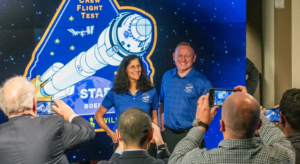NASA astronauts Sunita “Suni” Williams and Barry “Butch” Wilmore have returned to Earth after an unexpected nine-month mission aboard the International Space Station (ISS). Initially scheduled for a brief stay, their mission was extended due to technical issues with their return spacecraft, leading to a prolonged period in microgravity. NKTV+4The Guardian+4New York Post+4The Guardian+1The Guardian+1
The Extended Mission:
Williams and Wilmore arrived at the ISS on June 6, 2024, aboard Boeing’s CST-100 Starliner, intending to conduct a short-term mission to evaluate the spacecraft’s performance. However, technical malfunctions, including thruster issues and helium leaks, rendered the Starliner unsafe for their return. Consequently, NASA and Boeing decided to send the capsule back to Earth unmanned in September 2024, leaving the astronauts to continue their work aboard the ISS. The Guardian+1The Guardian+1
The Return Journey:
After months of uncertainty, a SpaceX Dragon capsule was prepared to facilitate their return. The capsule undocked from the ISS at 1:05 a.m. ET on March 18, 2025, beginning a 17-hour journey back to Earth. The spacecraft successfully splashed down off the coast of Florida at approximately 5:57 p.m. ET, where recovery teams were on standby to assist the astronauts. The Guardian+1The Guardian+1The Guardian
Physical and Psychological Challenges:
Extended exposure to microgravity poses significant challenges to the human body. Astronauts often experience muscle atrophy, bone density loss, and fluid redistribution, which can lead to swelling and vision changes. Upon return, they may face difficulties with balance, coordination, and cardiovascular regulation. To mitigate these effects, Williams and Wilmore will undergo a comprehensive rehabilitation program at NASA’s Johnson Space Center, including physical therapy to rebuild muscle strength and bone density, as well as cardiovascular exercises to readjust to Earth’s gravity. NKTV+3New York Post+3New York Post+3
Psychologically, the transition from the isolated environment of the ISS to the sensory-rich Earth can be overwhelming. Astronauts must readapt to social interactions, environmental stimuli, and the complexities of daily life on Earth. NASA provides support through counseling and reintegration programs to ensure a smooth transition.New York Post
Public and Media Attention:
The extended mission garnered significant media attention, not only due to the technical challenges but also because of noticeable physical changes in the astronauts. Observers noted that Williams returned with visibly grayer hair, sparking discussions about the effects of space travel on aging. While no direct studies link spaceflight to hair graying, factors such as oxidative stress and the absence of hair dye aboard the ISS may contribute to such changes. New York Post
Looking Ahead:
The safe return of Williams and Wilmore underscores the resilience and adaptability of astronauts facing unforeseen challenges. Their experiences will provide valuable data for future long-duration missions, especially as space agencies worldwide prepare for extended journeys to Mars and beyond. The lessons learned from their prolonged stay will contribute to developing strategies to mitigate the physical and psychological impacts of extended space travel.NKTV+3The Guardian+3The Guardian+3
In the coming weeks, both astronauts will continue their rehabilitation and share their experiences, offering insights into the realities of long-term space habitation and the human spirit’s capacity to endure and adapt.



